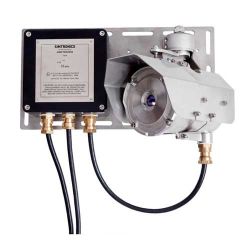Fixed gas detectors
A fixed gas detector - or gas transmitter - is a gas sensor dedicated to the measurement of gas concentrations in the air, it forms the first element of a fixed gas detection installation. Many sensors are available for the detection of explosive combustible gases (natural gas, LPG, hydrocarbons, solvents, alcohols), toxic gases, volatile organic compounds (VOCs), asphyxiating gases (lack of oxygen) or freons (refrigerants).
A fixed gas detector provides 24/7 protection against gas leak risks. Generally used with a gas detection controller unit, it can also be connected to a PLC or a supervision system.
-
-
-
-
-
-
-
-
-
OLCT100 fixed gas detector - ATEX SIL2 combustible, toxic & refrigerant gas
Starting at €775.00Quickview -
-
-
-
-
-
-
-
OLCT80 wireless fixed gas detector with Modbus, 4-20 mA outputs & alarm relay
Starting at €1,225.00Quickview -
-
-
-
Infrared fixed gas detector for hydrocarbons or CO2 - Simtronics GD10P
Starting at €2,445.00Quickview -
-
4-20 mA output fixed gas detector
The analog 4-20 mA output fixed gas detector represents the vast majority in the world of fixed gas detection. It is a very versatile linear output sensor gas transmitter since it can be connected to all devices receiving this type of universal signal. Some more advanced gas transmitter models have in addition a digital display of the measurement, alarm relays for the controls, MODBUS communication or even TCP / IP communication for the most powerful.
Fixed gas detector measurement technology
Catalytic sensor
Catalytic sensors are mainly used for the detection of combustible gases and vapors. Fixed gas monitors with catalytic sensors are very effective for the detection of natural gas, LPG, hydrocarbons, solvents and even certain volatile organic compounds. The catalytic sensor is inexpensive but cannot discriminate between different explosive gases.
Pion photoionization lamp
Mainly used for VOC detection (volatile organic compounds), the PID photoionization lamp is a somewhat special technology - insensitive to poisons and high concentrations - that detects many gases without, however, discriminating between them. Fixed gas detectors use two types of PID lamps: the 10.6 eV for most VOCs and 11.7 eV (very expensive and short lifespan) for VOCs with IP power> 10.6 eV
Electrochemical sensor
Among all sensor technologies, the electrochemical sensor is the most widespread and mainly used for toxic gases and oxygen fixed gas detection. Unlike the two previous technologies, it discriminates gas relatively well but remains very sensitive to interference which can significantly distort the measurement.
Infrared sensor
The infrared sensor is mainly used for explosive combustible gases detection(when the IR curve is available) and CO2 monitoring(carbon dioxide). It is a more expensive technology than catalytic diffusion technology but with a very long lifespan, a fast response time and immunity against catalytic poisons.
Semiconductor sensor
The semiconductor sensor is mainly used for refrigerant gas detection (refrigerant leaks) as well as certain solvents. This fixed gas detector measurement technology is very sensitive to interferers.
Fixed gas detectors applications
VOC monitors - Oxygen O2 monitors - Boiler room gas detection - Refrigerant gas leak detectors
See also
Gas detection controllers
-
Sirens & signals
-
ATEX accessories
-
Gas solenoid valves
Optical flame detectors
-
Calibration gas
-
Gas detectors by target gas
-
Portable gas detectors



